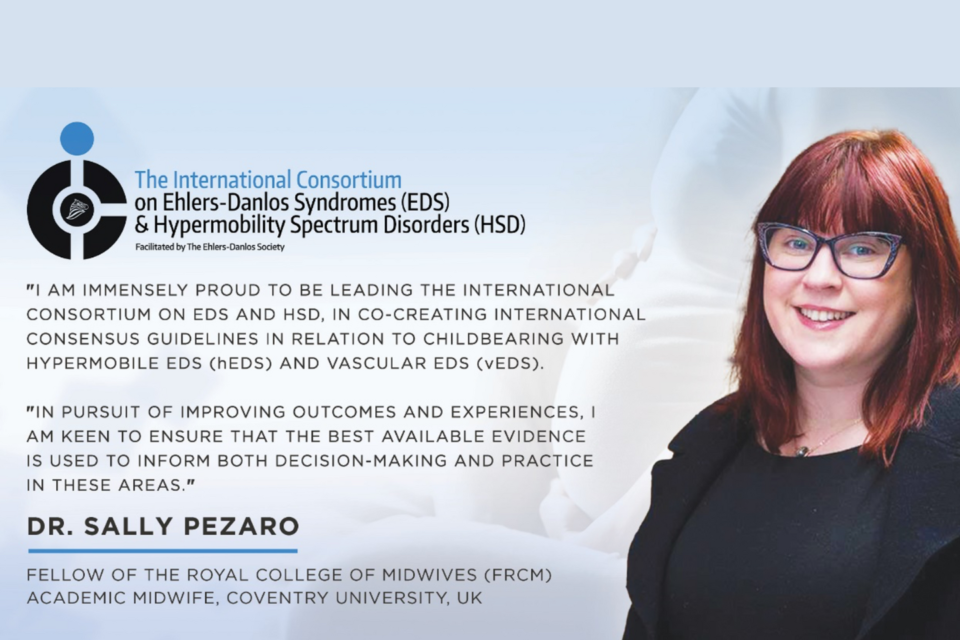This week in October has been allocated International Bone and Joint Week, aiming to focus on the thousands of people who have Musculo-skeletal conditions. These affect more women than men and are more likely to lead to discrimination and health inequalities. Dr Sally Pezaro highlights work and resources on childbearing with syndromes and disorders related to hypermobility, to help midwives to meet these individuals’ needs in particular.
_______________________________________________________________________________________________________________________
Childbearing with hypermobile Ehlers Danlos Syndrome and Hypermobility Spectrum Disorders
: research and evidence for practice
As it is Bone and Joint Awareness Week (#BoneJointWeek) I wanted to highlight some of the work being undertaken in the field of childbearing with hypermobile Ehlers Danlos Syndrome (hEDS) and Hypermobility Spectrum Disorders (HSD).
In these conditions, connective tissues are affected in a variety of ways throughout the body. Recent estimates in relation to hEDS/HSD present a diagnosed prevalence rate of 1 in 500 overall. Moreover, hEDS/HSD is also thought to affect almost 1 in 20 pregnancies worldwide. hEDS and HSD require essentially the same management and are therefore often referred to simultaneously.
Commonly shared symptoms include skin hyper extensibility along with joint hypermobility and easy bruising. Other symptoms may include joint dislocations, poor healing, and fatigue. Yet as connective tissues are situated throughout the body, any organ and/or bodily system can be affected.
Back in 2018, we assimilated the existing literature and published care considerations on this topic: Hypermobile Ehlers-Danlos Syndrome during pregnancy, birth and beyond. This article remains the British Journal of Midwifery’s most widely read, though evidence in relation to these conditions remains sparce, particularly in relation to childbearing. We followed this work up with a clinical update on hypermobile Ehlers-Danlos syndrome during pregnancy, birth and beyond along with our own original research ‘Understanding hypermobile Ehlers-Danlos syndrome and Hypermobility Spectrum Disorders in the context of childbearing: An international qualitative study‘. These activities led us toward the co-creation of several tools hosted via www.hedsTogether.com, and a short online course hosted by the Royal College of Midwives’ i-learn platform (search for ‘hypermobile’ under ‘coffee time learning’). Co-creators included partners from the Royal College of Midwives, the make birth better network, the Royal College of Obstetricians, the Ehlers Danlos Society, Ehlers-Danlos Support -UK and the hypermobility syndromes association.
There is a vast spectrum of things to consider in the effective management of childbearing with hEDS/HSD, particularly when those with the condition may be affected in different ways. For some, symptoms will be mild, yet for others, symptoms may be debilitating. Through further collaboration we were able to co-create a toolkit to support decision making and care planning in practice. This toolkit is freely available for download here. You can also learn more about using this tool in practice along with hEDS/HSD and childbearing in our newly co-created infomercial here. This project was awarded the Royal College of Midwives award for Partnership Working in 2021.
I am very proud to be lead midwife and part of the Coventry University based core team at www.hEDSTogether.com, where our future projects will be showcased. You can find and follow hEDSTogether on social media too for recent updates.
I am also honoured to act as an invited member of the Ehlers-Danlos Society’s International Consortium. In this role I am currently leading the Pelvic Floor and Bladder Disorders Working Group along with many other expert members of The International Consortium on the Ehlers-Danlos Syndromes and Hypermobility Spectrum Disorders, to produce guidelines for the management of pregnancy, birth, and post-natal recovery in the context of hEDS/HSD, and vascular Ehlers-Danlos syndrome (vEDS). You can read more about this project here.
During the summer of 2022, I was also bestowed with the Ehlers-Danlos Society’s ‘Outstanding Consortium Member of the Year’ award.
This award honours a person with unparalleled dedication to the International Consortium on Ehlers-Danlos Syndrome and Hypermobility Spectrum Disorders who has demonstrated a commitment to supporting patients and working for awareness and education for the wider community. This is something I will continue to do as long as we are able to make positive impacts in this area.
I get to work with amazing people all over the world. I particularly enjoy inter-professional working in partnership with those outside of the midwifery profession. Going forward I will continue to highlight and share advances in this area – The best is yet to come.
Dr Sally Pezaro, Centre for Healthcare Research, Coventry University
October 2022



